One of the most critical parts of advertising is choosing the right bidding strategy for your campaign. However, with so many conflicting viewpoints (usually data backed and/or voiced by experts), it can be hard to understand what the right strategy for your client(s) should be.
To that end, we wanted to examine two key questions:
- Which bidding strategy performs best over the most accounts?
- When advertisers use more than one bidding strategy, what percentage of ad spend goes to which strategy?
Methodology: Data Framework and Key Questions
First, let’s look at how this study is organized. We divided the data and questions into the following sub-questions:
- Which is the best overall bidding strategy: Smart, Auto, or Manual bidding?
- Do bidding strategy targets help improve campaign efficiency?
- Do bid caps help improve campaign efficiency?
- What are the real conversion thresholds for optimal performance?
- Does spend influence the success of a bidding strategy?
- What percentage of advertisers use more than one bidding strategy?
- Does The Data Translate To Lead Gen & Ecommerce?
Criteria and Definitions
To answer these questions, we did a deep dive into the international Optmyzr customer base. This study looks at all Google bidding strategies (with some inferences applicable to Microsoft Ads) across 14,584 accounts. We applied the following criteria:
- Accounts must be at least 90 days old.
- Accounts had to have conversion tracking configured.
- Accounts must spend at least $1,500 and could not spend more than $5 million per month.
Before we dive into the data, it’s important we clarify a few key terms:
- Smart bidding — Bidding managed by an ad platform based on conversion data
- Auto bidding — Bidding managed by an ad platform based on clicks or impressions
- Manual bidding — Bid and bid adjustments managed by a human
1. Which Is the Best Overall Bidding Strategy: Smart, Auto, or Manual Bidding?
Before we go over observations and takeaways, it’s really important to understand that the data may point to a ‘winning’ strategy that may not work for you and your business. Always factor in your own business conditions before making bidding decisions.
We’ll first share with you the raw data, then we’ll share the ranking based on weighting the following metrics in descending order:
- ROAS: 40%
- CPA: 25%
- CPC: 15%
- Conversion Rate: 10%
- CTR: 10%
Observations:
- Max Conversion Values continues to beat Max Conversions with a significantly better ROAS, CPA, CPC. While conversion rate and CTR are slightly better for Max Conversions, Max Conversion Value wins where it matters (ROAS).
- Max Clicks delivers acceptable performance and is an underutilized bidding strategy.
- Manual CPC is not the outright winner in any category, but delivers strong performance. The caveat to this is it’s not as efficient for CPA, CTR, or conversion rate.
- Target Impression Share’s metrics indicate top-of-page placement helps CTR and conversion rate, but won’t actually help with profit metrics (CPA, ROAS).
Takeaways:
There is no clear winner between Smart, Auto, and Manual bidding. All three types have strong and weak metrics.
- Max Conversion Value is the most efficient Smart bidding strategy.
- Maximize Clicks is the most efficient Auto bidding strategy.
- Manual bidding has the third highest ROAS, but really struggles in other categories. As such, you should only use it when you can actively manage the bids (more on this in the tactics section).
- There is room for testing as the stronger bidding strategies have less adoption than their weaker counterparts.
2. Do Bidding Strategy Targets Help Improve Campaign Efficiency?
With regard to targets, there are essentially two schools of thought: they’re either useful to help guide the algorithm or they represent risk due to human error.
Here’s what the data says:
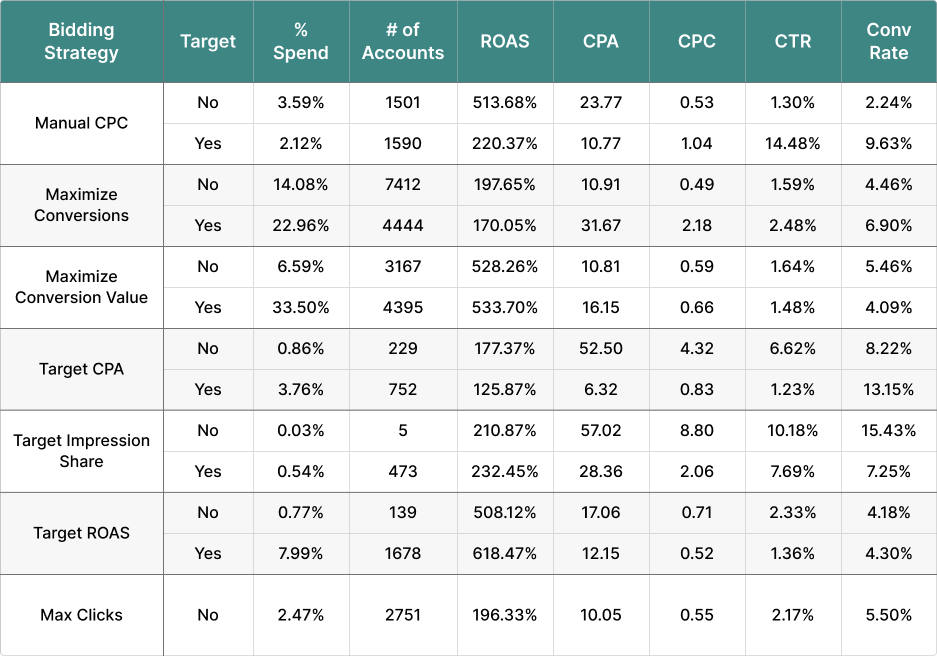
Observations:
- The majority of advertisers using Max Conversions do not set a target and see better performance on the most important KPIs like ROAS and CPA than those who do.
- It’s a similar story for Max Conversion Value; advertisers who do not define a target see improved results for all metrics except ROAS which has a slight dip but is essentially flat. However, the majority of advertisers do set a goal.
- There doesn’t appear to be a bidding strategy that significantly benefits from adding a goal, which is unfortunate because adding goals is tied to bid caps and floors. It’s unclear if this is due to human error or the nature of goals themselves.
- This is where we get to see the real impact of eCPC (retiring March 2025). While conversion rates and CPA are great, the ROAS doesn’t meet expectations. However it is worth noting that eCPC beat Max Conversions
Takeaways:
- Setting targets for bidding strategies has a higher likelihood of hurting accounts than helping them.
- The only bidding strategies where targets appear to help are Manual bidding and Target ROAS. It seems reasonable to assume that if an advertiser is willing to take on the work of bid adjustments and accurate revenue/profit sharing, they will set accurate bidding goals.
3. Do Bid Caps Help Improve Campaign Efficiency?
One of the biggest reasons to opt into bidding goals is to access bid caps (and floors). A bid cap is the most you’re willing to let Google bid, while the floor forces Google to use a minimum bid for all auctions. You can access these settings through portfolio bidding strategies for Smart bidding and Max Clicks/Target Impression Share.
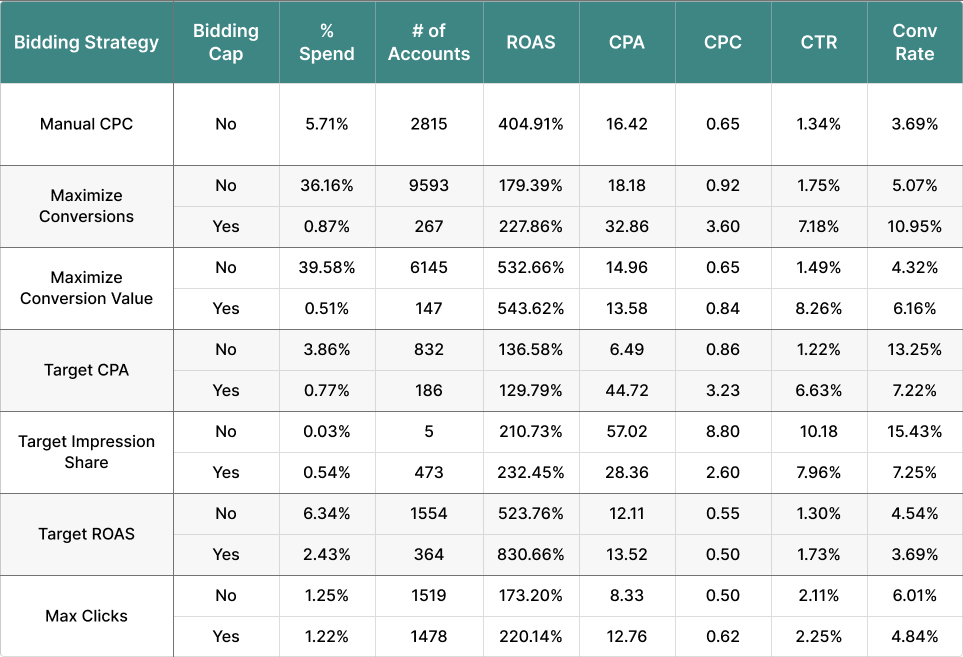
Observations:
- Whether or not bid caps are used has no consistent impact on performance, which explains why most advertisers don’t use them. This also explains why some advertisers avoid bidding goals (given that bid cap access is one of the big benefits of goals).
- ROAS-oriented bidding strategies seem to benefit the most from bid caps. CPA-oriented bidding strategies are mixed (decent ROAS, but weak CPA and CPC). CTR and conversion rates are strong but not strong enough to make up for almost double the CPA.
- While Max Clicks appears to have mixed results with bid caps, Target Impression Share clearly needs them (note: there wasn’t a statistically significant sample size for non-bid cap Target Impression Share).
Takeaways:
Most advertisers don’t use bid caps. Whether this is a good or bad thing depends on the bidding strategy.
- Bid caps are not inherently good or bad, however they do introduce the potential for human error.
- Bid caps (and floors) only make sense to use if you also apply intelligent bid caps and floors.
4. What Are the Real Conversion Thresholds for Optimal Performance?
We’ve long since passed the ‘15 conversions in 30 days’ era of Smart bidding. Ad platforms recommend that we meet minimum thresholds to see success. However, we weren’t sure what the threshold actually is for different types of bidding strategies…enter the data!
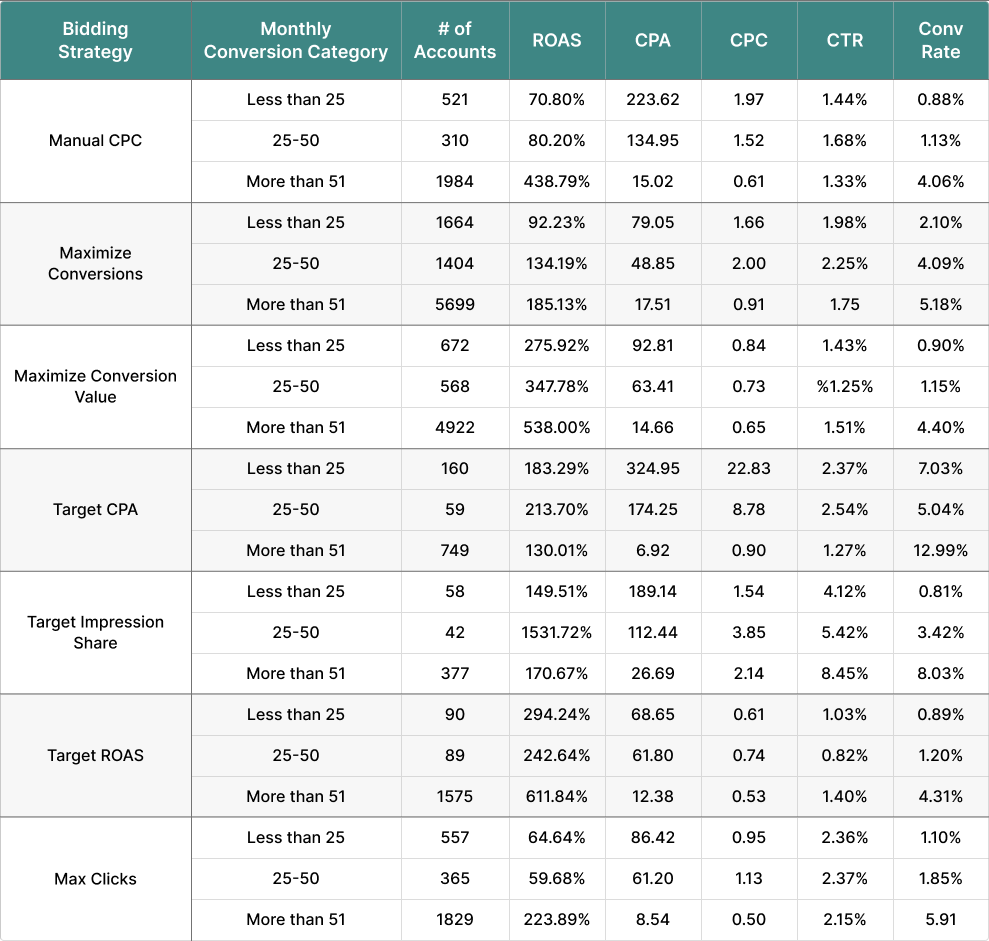
Observations:
- Most advertisers clear 50+ conversions in a 30-day period and see better performance compared to accounts with fewer conversions.
- The jump from under 25 conversions to 25–50 conversions doesn’t always result in a performance improvement. This may explain why some advertisers don’t trust Smart bidding at lower conversion volumes.
- Manual bidding also benefits from high conversion volume.
- Max Conversion Value has a slight edge over Max Conversions at all conversion volumes, indicating that Google has an easier time working with conversion values than stand alone conversions.
Takeaways:
The threshold for any bidding strategy to be predictably successful is 50+ conversions.
- Some success can happen at lower thresholds, but there’s more volatility.
- Manual bidding also benefits from higher conversion volumes, so if your only reason for choosing manual bidding is your lack of conversion data, we recommend finding ways to increase conversion volume.
5. Does Spend Influence the Success of a Bidding Strategy?
One of the most common assumptions around Smart bidding is that it requires big budgets to be successful. We were curious if this held up across all bidding strategies.
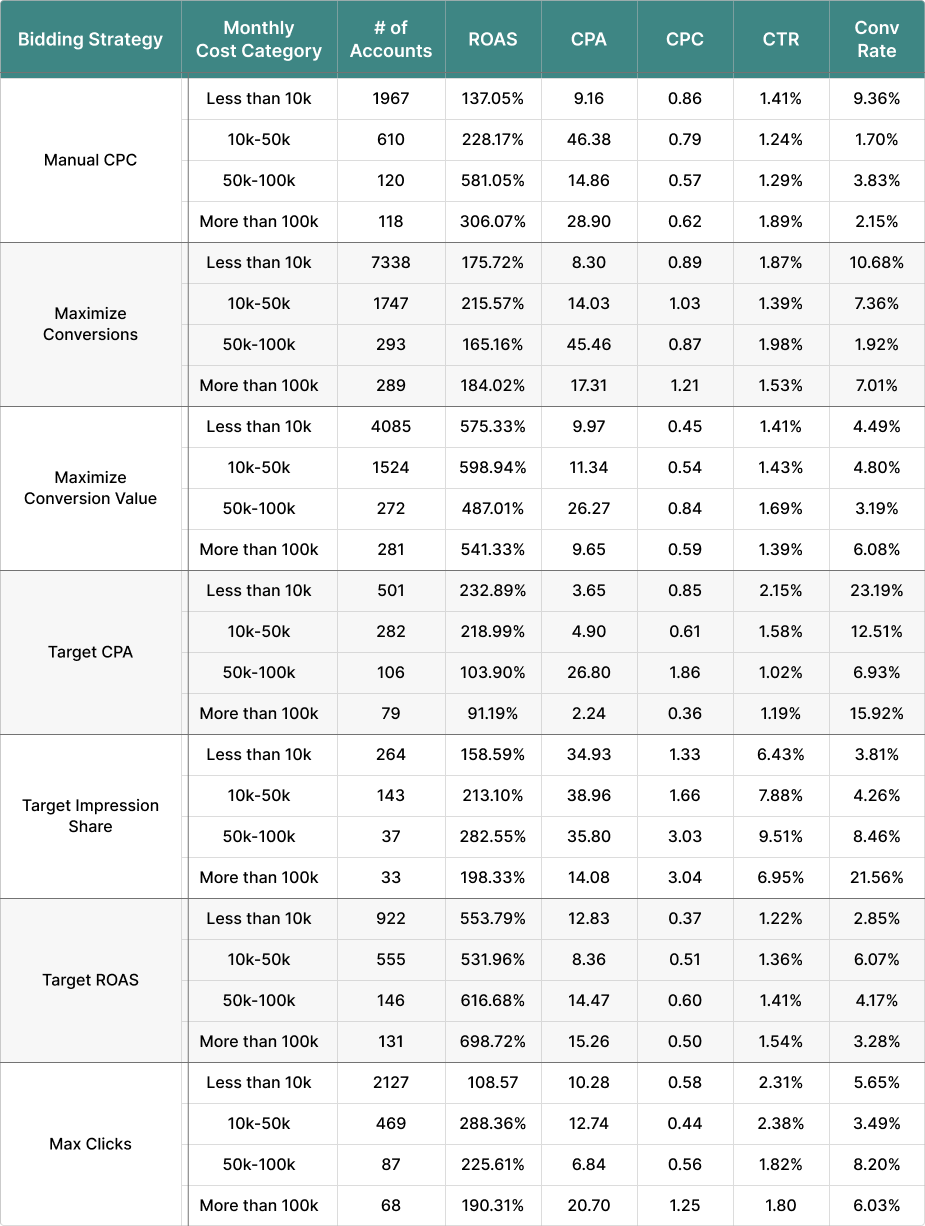
We ranked the bidding strategies by their probability to achieve profitability at lower spend levels (using the same criteria as before) from highest to lowest:
Observations:
- The only bidding strategy where performance consistently improves as spend increases is Manual bidding.
- The sweet spot for Smart bidding appears to be $10K–$50K (focusing on ROAS and CPA). Conversion rate and CTR seem to favor higher spend, but those aren’t profit metrics, which might explain why some brands tank their campaigns with large budget shifts if/when they move to Auto or Smart bidding).
- Most advertisers using Max Clicks are low budget accounts, which makes sense given the conventional wisdom that ad accounts need big budgets for conversion-based strategies.
Takeaways:
- As long as you have the conversions, low spend shouldn’t get in the way of Smart bidding.
- The only bidding strategy that seems to handle big changes to budgets consistently is manual. Every other bidding strategy does best with specific spend brackets.
6. What Percentage of Advertisers Use More than One Bidding Strategy?
An interesting finding that came out of the data is exactly how many advertisers use multiple bidding strategies in the same account.
Category | COUNT of accounts | % of accounts |
Multiple bidding strategies | 7,061 | 48.42% |
Single bidding strategies | 7,523 | 51.58% |
Observations:
- Most advertisers use the same bidding strategy throughout their account.
- Those using multiple bidding strategies seem to have a ‘starter’ bidding strategy as campaigns ramp up, and then transition to others.
- Those sticking with one bidding strategy seem to have ‘loyalty’ to one. They stick with the same bidding strategy regardless of performance fluctuations.
Takeaways:
Testing bidding strategies is healthy but it’s not mandatory for success. Clinging to one bidding strategy may be comfortable, but it’s not as risk averse as it seems.
7. Does The Data Translate To Lead Gen & Ecommerce?
There is no denying lead gen and ecommerce strategies are different. As such we wanted to share the data of how bidding strategies fared with each account type.
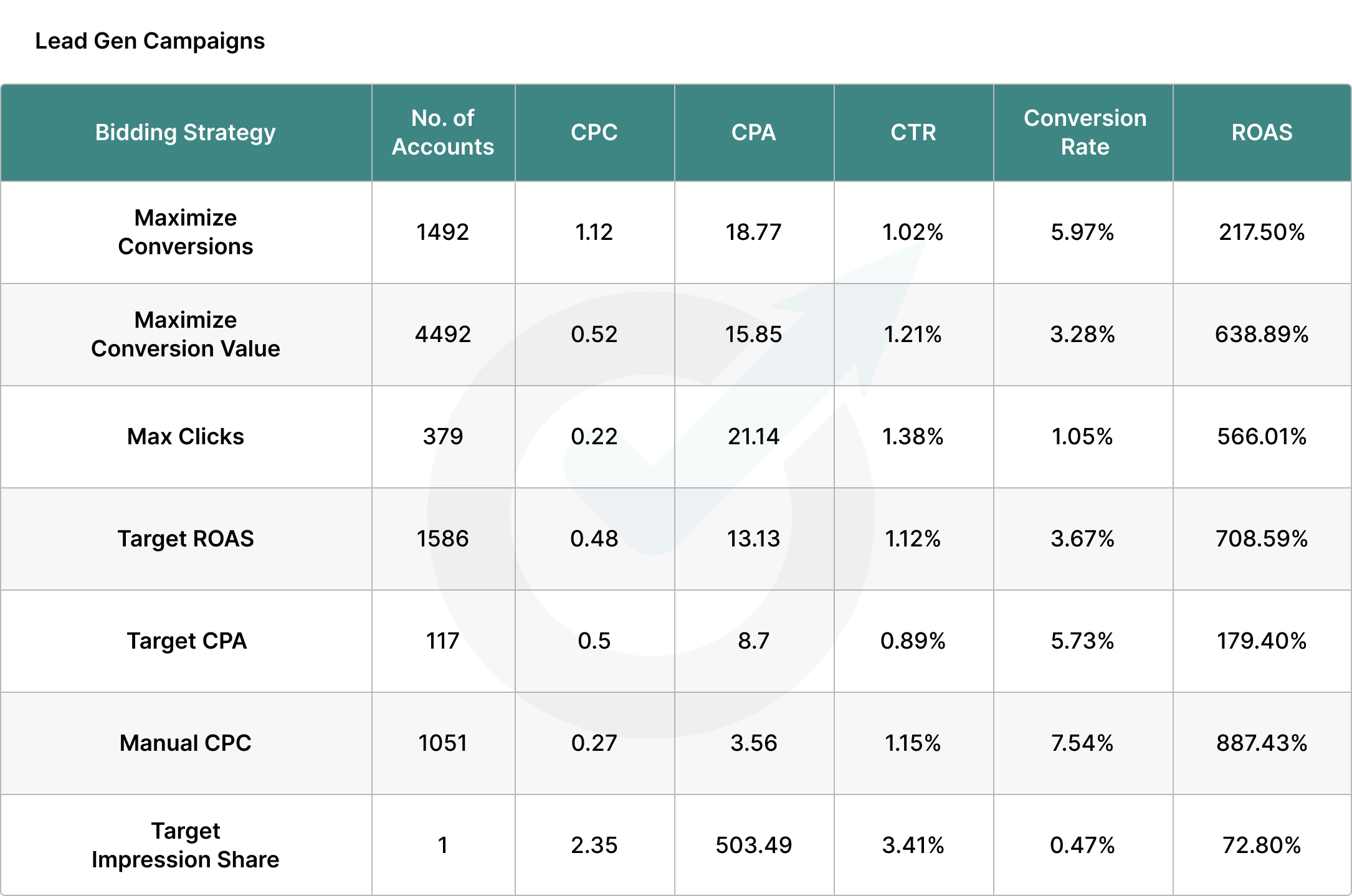
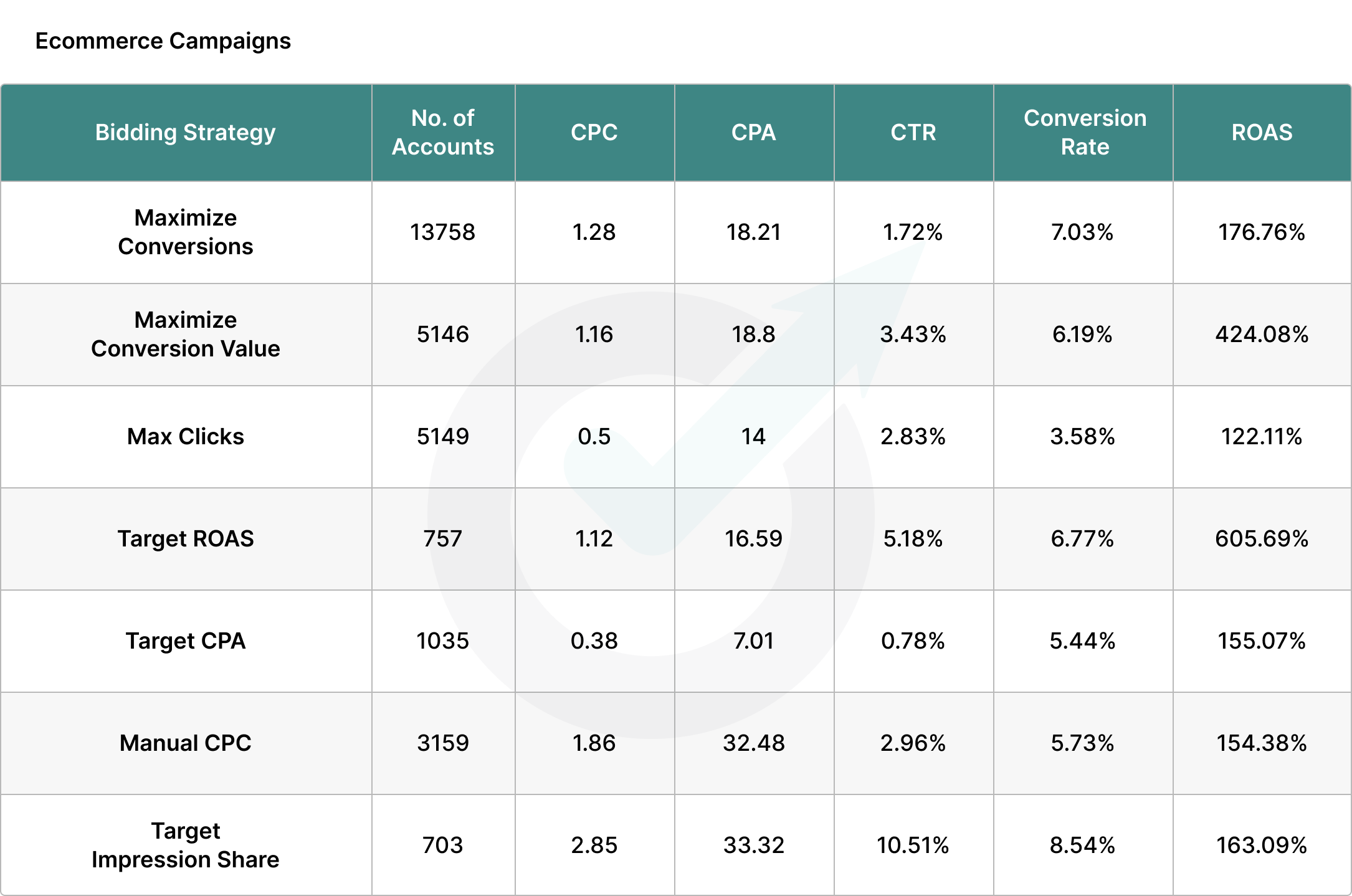
Observations:
- Max Conversion Value continues to dominate in lead gen. While CTR and Conversion Rate are lower than ecommerce, all metrics beat out Max Conversions.
- Ecommerce advertisers seem to struggle with Manual CPC and Max Conversion bidding. I find it odd how many ecommerce advertisers are using Max Conversions instead of Max Conversion Value.
- While more ecommerce use Max Clicks, lead gen advertisers seem to do better with it. Manual CPC seems to be the safer “early stage” campaign bet (despite it being a weaker bidding strategy overall for ecommerce).
- The most popular bidding strategy for the studied ecommerce cohort is Max Conversions. The most popular bidding strategy for the studied lead gen cohort is Maximize Conversion Value. This was a shocker, because
- Some of the cheapest Lead Gen CPCs and strongest ROAS was with Max clicks and manual CPC.
Takeaways:
Lead Gen Max Conversion Value outperforms Max Conversions by almost 300% on ROAS. This supports advertisers using Max Conversion values regardless of whether they are lead gen or ecommerce.
Tactics from the Data
There are a lot of tactics that come out of the bidding strategy data, but the biggest one is not to fall into the trap of thinking that Smart or Auto or Manual are inherently better or worse than the other. It all comes down to execution and where your account is on the conversion volume/efficacy front. Many accounts use mixed bidding strategies, which speaks to the value of leveraging all the bidding strategies at each stage in the account.
As a general rule, Manual and Auto bidding are favorable in early stage accounts. This is because these bidding strategies aren’t reliant on conversions and represent learning opportunities around auction price. As an account ramps up, it’s reasonable to start testing Smart bidding (provided that you have at least 50 conversions in a 30 day period).
However, just because an account is low-budget doesn’t mean that it can’t see success with a Smart or Auto bidding strategy:
- High-spend accounts ($100K+) didn’t always fare better than lower-spending accounts (i.e., less than $10K).
- Maximize Conversions had a median conversion rate of 10.68% on low-spending accounts, while high-spending accounts had a conversion rate 7.01%.
- While it’s true that the ROAS was slightly better (at 184% versus 175%) with higher spend, it doesn’t change the fact that the CPAs, CPCs, and click-through rates were better at less than $10K spend.
However, conversion thresholds still matter. There is no account that performed better at less than 25 conversions than those that had more than 50. In fact, even Manual bidding did demonstrably better on cost per acquisition, ROAS, click-through rate, CPC, and conversion rate when there were more conversions.
The big takeaway here is that just because your spend is low doesn’t mean you have to shy away from Smart bidding, but it does mean that you need to be honest about your conversion actions. In terms of which conversion actions you include, you can consider using micro conversions if you want to avail yourself of Smart bidding, but it’s really important that you actually put in the different conversion values for each action so that Google can get the data it needs to efficiently allocate your budget.
The other major optimization opportunity within the account is thinking about how you allocate your budget. Of all the bidding strategies, only Manual bidding had a linear correlation between budget size and bid performance. However, when you look at all the other bidding strategies, big spikes or decreases in budget did cause performance issues.
As a general rule, when you’re increasing or decreasing a budget in a Smart bidding campaign, you’ll want to make sure that you allocate somewhere between two to three weeks for that budget to settle.
In regards to bid caps and floors, as well as setting targets, I was surprised that targets seemed to hurt performance more than help it. And while I have my suspicions that human error (seting caps/goals that don’t align with the budget and targets) is part of the issue, there is no denying that applying a target represents risk.
If you’re going to use targets, which unlock the path to bid caps and floors (that can lead to performance improvements in certain cases), ensure that you apply the right targets (and bid caps and floors).
The first thing to consider is what a reasonable target for your campaign might be. So if you historically hit a $50 cost per acquisition or a 200X ROAS with no goal, it is reasonable to set a cost per acquisition goal of $45 to $55 not see any major change (i.e., you are keeping the goal +/-10% of the original performance). The moment you go beyond that 10%, you invite risk. And so the only reason to do this is if you know that the historical performance doesn’t reflect the actual results you are seeing.
For example, if you know that your conversion tracking isn’t set correctly, or if you don’t trust your data, you can play a little bit faster and looser with the settings, because the information that’s currently fed to Google isn’t accurate. And as a reminder, you may decide that you want to exclude certain data that you know you don’t trust.
When it comes to bid caps and floors, I have always endorsed keeping bids to 10% (or less) of your daily budget, so you can fit at least 10 clicks per day.
If you choose to go beyond that 10%, there’s a very real chance that you will not get enough clicks per day, and Google will either under serve your budget, or your bid floors will be too low, you’ll over serve in the wrong auctions, and you will have misguided your budget.
When setting up your bid floors and caps, be mindful that you’re doing so as corrections, not as a control lever. If you see that your impression share is historically lost due to rank, you may decide that you want to set a higher bid floor (while not including a cap) to force Google to invest your budget in the way that will serve you.
If you’re struggling on quality, you may decide that you want your bid cap to be 10% or even 15% of your daily budget, but acknowledge that you’ll get fewer clicks per day. So, you just have to account for that in your conversion rates. It’s really critical that you’re honest about the quality of your leads and what those bid caps and floors can do for them, as well as making sure that your targets are reasonable based on your historical performance.
Experts React
“This study challenges many misconceptions about Google Ads, which is thrilling! Seeing that campaigns using Target CPA achieve the lowest CPA of all bid strategies, and that campaigns using Target ROAS achieve the highest ROAS of all bid strategies, confirms the effectiveness of target-based Smart Bidding.
The most important takeaway from this study for me, however, is that budget is not the most important factor in Smart Bidding success; conversion volume and values are. Increasing your budget does not mean you’ll achieve better efficiency, but increasing your conversion volume is correlated to better results for every single bid strategy studied.
Going forward, I will continue recommending that my clients implement micro-conversions if they don’t have sufficient conversion volume, and continue recommending using conversion values even for non-ecommerce businesses.“
Jyll Saskin Gales, Founder and Coach, Jyll.ca
“My question as I read through all the data was - what percentage of the accounts reviewed were e-commerce? I’d love to see how the data shakes out across these categories for e-commerce and lead generation.
But even without that split being shown, seeing that accounts really do need 50+ conversions is validating! As someone who often works on accounts with low (fewer than 50 per month) conversions, I have long believed that those conversion levels were a hinderance and seeing it confirmed in a large data set is helpful.
It is also nice to see that manual bidding does have a place in these automated times! The data about using conversion values and not just bidding toward conversion generally was also very interesting. I think we can sum up where things are continuing to go by saying Google wants more information from advertisers (conversion values being one data point) so that it can add that to their system data to try to increase campaign performance.
Also nice to see that adjusting your budgets with some of the auto or smart strategies can cause volatility. Again, many of us see things in the accounts we work on and hear about it from friends and their accounts, but seeing a large data set reporting that it is widespread is also very helpful in setting expectations - both ours and for our clients.”
Julie Friedman Bacchini, Founder of PPC Chat/President and Founder of Neptune Moon
“One of my first takeaways is that max clicks performs at a similar if not better level than max conversion. As was noted, maximize clicks is really an underutilized bidding strategy as users try to jump straight into smart bidding using maximize conversions. I’ve found that using maximize clicks with appropriate bid adjustments can actually be a winning strategy for some accounts.
I wasn’t surprised to see that the key component in bidding strategies continues to be conversions and conversion volume, however. This remains one of the biggest challenges for smaller advertisers and even manual CPC or auto bidding doesn’t entirely overcome the challenge. The importance of micro conversions only continues to grow for marketers who work with lower conversion volumes.
I’ll also admit that this study challenges my view on maximize conversion value as a bidding strategy. I’ve always thought that maximize conversions was a better bidding strategy and have often only used conversion value bidding if I can set a target ROAS with it. This serves as a good reminder to test your assumptions or at least avoid writing strategies off without due consideration!”
Harrison Jack Hepp, Founder of Industrious Marketing LLC
“Some big surprises here at first glance, but things are never simple. As the saying goes in the SEO community: “It depends,” and that holds true here as well. Take, for example, setting up targets and bid caps. The data shows that these strategies aren’t always beneficial. Does this mean we’ll change our advice to clients? Likely not. It may seem surprising until we consider who sets those numbers and based on what data. We’d still argue that in many cases, setting a CPA target while also establishing bid caps and floors is a balanced strategy—assuming the data is reliable.
In essence, the study confirms what we universally know: better data equals better performance. Unfortunately, not everyone understands what “better data” really means or how to achieve it. That’s where the complexity comes in, especially with increased focus on privacy. We’ve already been developing strategies to improve the data quality and the study confirms the need. Strategies such as server-side tracking which in testing is showing 18% uplift in main conversion event relative to client-side. This is all data that helps us and the system make informed decisions that manage risks. But again, it only works if the setup and measurement framework are solid from the start. That’s the difference between stunting your account’s performance and letting Google do as Google wants.”
Emina Demiri-Watson, Head of Digital Marketing, Vixen Digital
“This study provides really valuable insights into Google Ads bidding strategies. One surprising finding was the high usage of ‘Maximize Conversions’, despite its relatively low ROAS and high CPA. I understand that the accounts are using multiple bid strategies and the bigger picture is important but I found this interesting non-the less. As a proponent of Maximize Clicks, I’m pleased to see its performance validated. This bid strategy is particularly suitable for smaller businesses or those seeking a less hands-on approach. I recommend max clicks for alot of my b to b clients when there isn’t much competition and when the terms that are searched are straightforward. This data point is helpful to that cause.
The study also highlights the importance of conversion volume for manual bidding. This aligns with the traditional “rule of 100s,” where bids were adjusted based on performance metrics (100 clicks or more with no conversions lower the bid, or if a keyword spends $100 or more with no conversions lower the bid). While this is an old school way of doing manual bidding, we still relied on data to make the decision before smart bidding. Seeing this data shows that 15 years ago we weren’t as far from the mechanics as we thought.”
Sarah Stemen, Founder of Sarah Stemen LLC
“I always enjoy it when I get my hands on Google Ads studies that look at big data sets.This one about bid strategies provided great insights. Among the things I found confirmed from my own analysis are the importance of conversion volume as the basis of any bid strategy and that maximize clicks still has its place. It can perform the same or even better in certain scenarios.
What surprised me, as a proponent of bid floors and bid caps, was the section about bid caps not having a consistent impact on performance.
Guess that goes to show that, as the saying goes, it depends.
I was pleasantly surprised by manual CPC and the way it performs, but only when you actively manage the bids - but this always used to be the case and us “old schoolers” are used to it being that way.”
Boris Beceric, Founder and Coach, BorisBeceric.com
“I’m pleased to see that, as of today, there is still no universally superior bidding strategy; performance varies based on execution, conversion volume, and account specifics. When you have 50+ conversions, Smart Bidding is often the best approach, and this aligns with my observations.
A key takeaway for me is the quality of data we provide to Google. Different bidding strategies require different data inputs. It’s crucial to include micro-conversions when they are relevant, and the bid strategy must align with this data. When aiming to drive high-value deals, both the data quality and campaign setup are critical.”
Andrea Cruz, Sr Director, Client Partner Tinuiti
Final Takeaways
Bidding strategies should be evaluated based on the goals for the campaign and resources available. There is no concrete answer on which bidding type (Smart, Manual, or Auto) is better, however there are signals advertisers can follow for the best one for their campaign.
Just because you’re using Smart or Auto bidding doesn’t mean you lack control. If you’re interested in layering automation into your workflow and getting the most out of your budget, Optmyzr has several tools to help you on the path to profit and victory.
If you’re not an Optmyzr customer already, you can sign up for a full functionality trial here.










